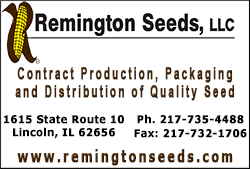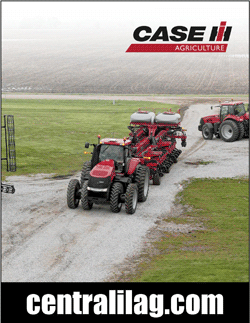 In a Purdue Extension report, "2,4-D- and Dicamba-tolerant Crops --
Some Facts to Consider," one of the concluding statements said:
"Often, there are no effective herbicides that are easily available
for some crops, or it is not desirable or possible to use more
intensive tillage on large acreages. The presence of glyphosate-resistant
weeds imperils the long-term sustainability of the RR (Roundup
Ready) system unless producers practice more integrated weed
management that relies less on the sole use of glyphosate." In a Purdue Extension report, "2,4-D- and Dicamba-tolerant Crops --
Some Facts to Consider," one of the concluding statements said:
"Often, there are no effective herbicides that are easily available
for some crops, or it is not desirable or possible to use more
intensive tillage on large acreages. The presence of glyphosate-resistant
weeds imperils the long-term sustainability of the RR (Roundup
Ready) system unless producers practice more integrated weed
management that relies less on the sole use of glyphosate."In
1998, the USDA National Agricultural Statistics Service began
publishing farmer surveys of pest management practices. Farmers were
asked to answer "yes/no" questions, which were then categorized for
the report into one of four pest management categories: prevention,
avoidance, monitoring and suppression.

Two tables were created for each crop: corn and soybeans. The
first table shows percent of planted acres; the second table shows
percent of farms.
Beginning in 2000, the survey reflects the introduction of
genetically modified soybeans, and soon to follow, corn traits with
insect and herbicide resistance.
Summaries below provide a look back at pest
management practices for the years 1997 and 2000. For a
page of related
tables (PDF), click here.
The USDA has shifted the survey of pest management practices to
the Agricultural Chemical Use Program. The new categories of
research were added, including specific use of fertilizers and
pesticides, as well as other valuable data.
The pest management practices portion of the 2010 corn crop
survey offered even more details, expanding to 97 specific action
items in each table representing percent of acres and percent of
farms.
Below is a summary and highlights of the 2010 corn crop:
The 2010 corn crop data represents 4,893 individual responses
from producers in 25 program states: Arkansas, Colorado, Georgia,
Idaho, Illinois, Indiana, Iowa, Kansas, Kentucky, Maine, Michigan,
Minnesota, Mississippi, Missouri, Nebraska, New York, North
Carolina, North Dakota, Ohio, Pennsylvania, South Dakota, Tennessee,
Texas, Washington and Wisconsin. These states accounted for 93
percent of corn acres planted nationwide in the 2010 crop year.

Pesticides
Herbicide active ingredients were applied to 98 percent of acres
planted to corn, and almost two-thirds of all active ingredients
used on corn were herbicides. Glyphosate isopropylamine salt was the
most widely used pesticide overall and the active ingredient used in
the greatest total amount.
Fungicide was applied to 8 percent of corn acres, and insecticide
active ingredients were applied to 12 percent of corn acres.
Pest management practices
Scouting for weeds was the top pest management practice on corn
acreage.
Top pest management practices by percent of corn acres planted:
-
Prevention: No-till or minimum till -- 62 percent
-
Avoidance: Rotated crops during past three years -- 71
percent
-
Monitoring: Scouted for weeds -- 88 percent
-
Suppression: Maintained ground covers, mulches or other
physical barriers -- 34 percent
[to top of second column] |
 Top pesticides by percent of acres treated:
Below is a summary and highlights of the 2012 soybean crop:
Pest management practices by percent of soybean acres planted:
-
Scouting for weeds was the most widely reported
monitoring practice -- 94 percent.
-
Crop rotation was practiced as the top avoidance practice
-- 84 percent.
-
No-tillage or minimum tillage represented the most widely
used pest prevention practice -- 67 percent.
-
Maintaining ground covers, mulches or other physical
barriers was the most reported suppression practice -- 35
percent.
The same practices were also the top practices for the last
survey of soybean crops in 2006.

Pesticide use
The pesticide active ingredients used on soybeans are classified
in this report as herbicides, insecticides, fungicides or other
chemicals. Herbicides were used most extensively, applied to 98
percent of soybean acres. Insecticides and fungicides were applied
to 18 percent and 11 percent of planted acres, respectively. Among
herbicides, glyphosate potassium salt was the most widely used (59
percent of planted acres), followed by glyphosate isopropylamine
salt (30 percent).
The next survey on corn is scheduled for 2015. Soybeans would be
surveyed next in 2017.
[LDN] For more information on these and other crops, visit the USDA's
National Agricultural Statistics Service page for the
Agricultural
Chemical Use Program.
Information on organic corn chemical usage and pest management
practices is included in the organic corn summary available in the
Quick Stats 2.0 database accessible from the page link above.
 |